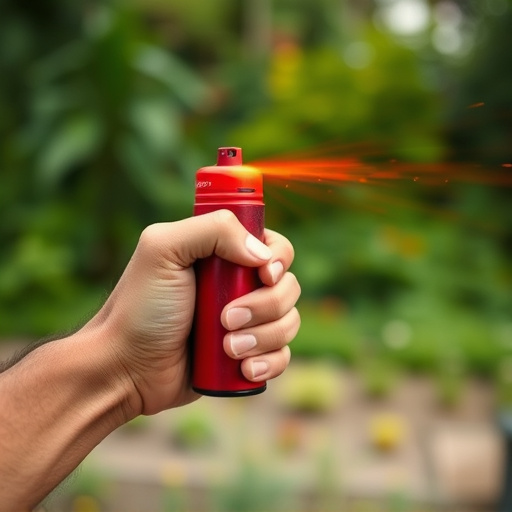Riot control agents, or less-lethal weapons like bear spray, are used by law enforcement to manage civil unrest, with their application governed by legal frameworks prioritizing public safety and individual rights. Effective use of bear spray involves specialized training, targeting sensitive areas like the face and eyes, and choosing high-quality sprays with potent active ingredients. Strategic application, combined with de-escalation strategies, has shown successful outcomes in urban settings, but challenges include weather conditions and complex crowd dynamics. Comprehensive training is crucial to enhance public safety during high-risk operations.
Riot control agents, particularly bear spray, have emerged as powerful tools in law enforcement, offering a non-lethal means to subdue and disperse aggressive individuals. This article delves into the legal framework surrounding these agents, exploring their effectiveness and the best practices for optimal application. We examine various types of bear spray, analyze successful case studies, and discuss challenges encountered in real-world scenarios, providing essential insights into the art of mastering best bear spray application techniques.
- Understanding Riot Control Agents and Their Legal Framework
- Types of Bear Spray and Their Effectiveness in Law Enforcement
- Best Practices for Safe Bear Spray Application
- Case Studies: Successful Implementation and Challenges Met
Understanding Riot Control Agents and Their Legal Framework
Riot control agents, also known as less-lethal weapons, are chemical or biological substances designed to disrupt and control crowds during civil unrest or large-scale gatherings. These agents operate by causing temporary physical disability, disorientation, or discomfort in the target individuals, enabling law enforcement agencies to regain order. The legal framework surrounding their use is a delicate balance between maintaining public safety and respecting individual rights.
In many jurisdictions, riot control agents are regulated under specific laws and guidelines that dictate their acquisition, storage, and deployment. For instance, best bear spray application techniques emphasize responsible usage, focusing on non-lethal force as a last resort. Law enforcement officers undergo specialized training to ensure they employ these agents within legal boundaries, minimizing harm and maintaining the integrity of crowd control operations.
Types of Bear Spray and Their Effectiveness in Law Enforcement
In the arsenal of law enforcement tools, bear spray stands out as a unique and effective riot control agent. Types of bear spray vary in terms of active ingredients, concentration, and application methods. The best bear spray for law enforcement purposes combines high concentrations of capsaicin or other irritants with reliable delivery systems, ensuring both safety and efficacy. These sprays are designed to create a protective barrier, temporarily incapacitating suspects without causing permanent harm.
When it comes to the best bear spray application techniques, officers should focus on direct aiming at the face and eyes, as these areas are highly sensitive. Proper training in usage and understanding the range and wind conditions are crucial for effective deployment. Law enforcement agencies must also stock a variety of spray can sizes, from compact models suitable for close quarters to larger ones for longer-range engagements. Regular maintenance and practice sessions with live agents further enhance officers’ proficiency in using bear spray during high-pressure situations.
Best Practices for Safe Bear Spray Application
When it comes to best practices for safe bear spray application, understanding proper technique is paramount. Officers should aim for the eyes and face, as this area is highly sensitive and can disable a bear effectively with minimal use. The spray should be applied in short bursts from a safe distance, typically 20-30 feet away, to ensure accuracy and prevent accidental misuse. It’s crucial to train regularly to build muscle memory, enabling quick and effective deployment during encounters.
Additionally, choosing the right bear spray is essential. Look for products with a high concentration of active ingredients like capsicum or oleoresin capsicum, which are known irritants to bears. Always check expiration dates and ensure the spray is in good working order before each use. Proper storage is equally important; store bear sprays in cool, dry places away from direct sunlight to maintain potency and safety.
Case Studies: Successful Implementation and Challenges Met
In recent years, law enforcement agencies have increasingly turned to riot control agents, particularly bear spray, as a non-lethal tool for crowd management and riot suppression. Case studies from various jurisdictions highlight successful implementations of bear spray, demonstrating its effectiveness in de-escalating tense situations. For instance, in urban settings, targeted use of bear spray has proven instrumental in dispersing violent mobs, allowing police to regain control without resorting to more harmful tactics. The strategic application of bear spray, often combined with de-escalation strategies and crowd control formations, has led to a reduction in injuries both among law enforcement officers and civilians.
However, challenges remain in the successful implementation of best bear spray application techniques. Weather conditions can significantly affect the range and effectiveness of the spray, requiring officers to adapt their tactics accordingly. Additionally, crowd dynamics pose complexities; in crowded spaces, the spray mist may disperse too quickly or be obstructed by barriers, making precise targeting difficult. Training is crucial for addressing these challenges, ensuring that officers are equipped with the necessary skills to assess situations, select appropriate equipment, and employ effective bear spray application techniques, thereby enhancing their ability to maintain public safety during high-risk operations.
Riot control agents, particularly bear spray, have emerged as valuable tools in law enforcement’s arsenal for handling crowds and protecting officers. By understanding the legal framework surrounding these agents and adopting best practices for their application, such as those discussed regarding safe usage techniques, agencies can maximize effectiveness while mitigating risks. The case studies presented highlight both successful implementations and challenges encountered, offering insights into the practical application of bear spray in diverse scenarios. Ultimately, ongoing training and adaptation to evolving tactics are crucial to ensuring the optimal use of riot control agents, including best bear spray application techniques, for modern law enforcement operations.
